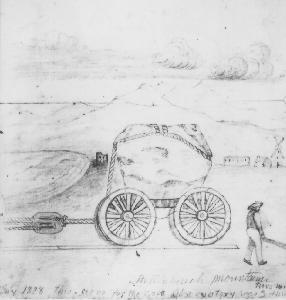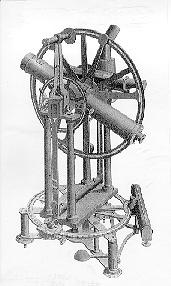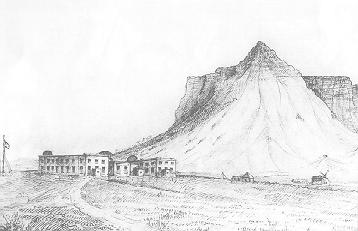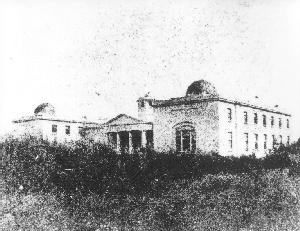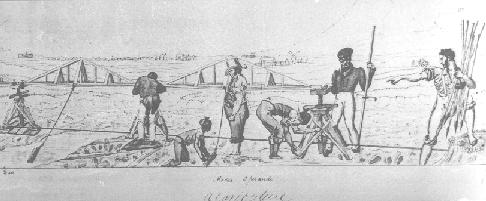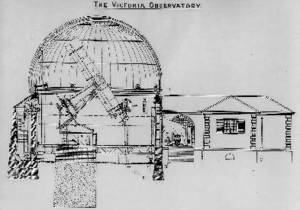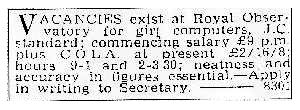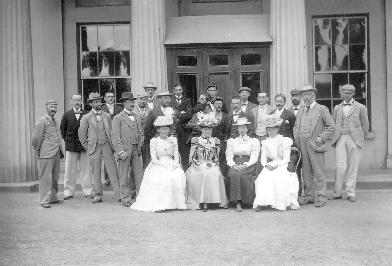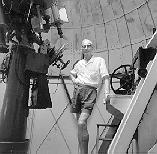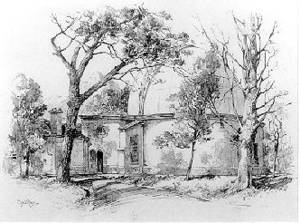Sailing by the stars
Modern astronomy in South Africa begins with ships – and their unfortunate habit of colliding with the South African coastline. Accurate positions for southern stars that might be useful to navigators were simply not available, and the position of the African coastline wasn’t very well known either.
In 1685 a French ship stopped briefly at the Cape so that Father Guy Tachard could set up a small temporary observatory. He and his assistants discovered that most of the stars shown on their charts of the extreme southern sky did not exist at the marked positions, while many others were omitted altogether. He also estimated (from observations of Jupiter’s moons) that Cape Town was nearly 300 km west of its position on his maps of the Earth.
The most notable early visiting astronomer at the Cape was Nicholas de la Caille, who spent two years (1751-53) charting the positions of almost 9 766 stars and measuring the shape of the Earth.
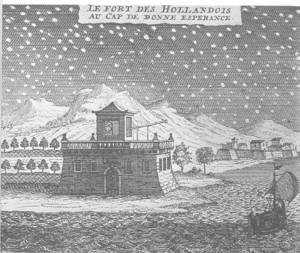
The Admiralty and the Divine
None of these temporary efforts had achieved high enough accuracy to satisfy navigators or astronomers, however, and on October 20, 1820 the ‘King’s Most Excellent Majesty in Council’ authorized the ‘… Lords Commissioners of the Admiralty to cause an observatory to be erected at the Cape of Good Hope …’, thus establishing the first permanent modern observatory in Africa.
As its head the Admiralty chose a brilliant young Cambridge mathematician, astronomer and clergyman who had studied books on mathematics while working at his father’s loom. He would need all his grit and determination…

An 1820 settler’s hut served as the first ‘Royal Observatory’. By 1834, it was part of a group of huts north of the new observatory building. (Watercolour by Thomas Bowler).
When the Reverend Fearon Fallows arrived at the Cape, he found himself landed in the wrong place (Simon’s Town) and with no way of getting his cargo of astronomical instruments to Cape Town except by putting them on another ship at his own expense. In Cape Town the British authorities not only refused all payment of ‘one penny’ of Fallows’ expenses on land or sea, but refused to give the observatory instruments any storage space. Only the intervention of President van Breda of the Burgher-Senate prevented the ship’s captain from dumping the unbuilt observatory’s first load of instruments on the beach.
As it was, Fallows was allowed a room in the town granary, and the government eventually granted him one of the pre-fabricated huts intended for settlers at Algoa Bay. From this hut (originally in Kloof Street) Fallows began observing the southern stars. His results from these early observations appeared as a catalogue of 273 ‘principal fixed Stars’ in the 1824 Philosophical Transactions of the Royal Society. Though intended as a first rough effort, Fallows’ positions for southern stars were at least as good as any others readily available at the time.
Faith in the Clerk of Works
The only one of Fearon Fallows’ portable instruments still at the observatory is a Dollond ‘repeating circle’, made of brass with inlaid silver vernier scales read by microscopes. (Engraving from Memoirs of the Royal Astronomical Society, 1822).
Moving one of the large stones needed for the instrument peers at the Royal Observatory. Two wagons were broken trying to move these massive blocks, and Henderson wrote that the largest block had to spend three weeks reaching the observatory on rollers.
But getting the permanent observatory built was another matter. Most possible sites were plagued by sand and dust storms or local ‘tablecloth’ clouds, and finding a site took nearly a year. The better part of three more years went by as the Admiralty Office mislaid and redrew the plans, and the ground selected turned out to be claimed by several different local inhabitants, each of whom had to be paid off to avoid lawsuits.
When a contractor was finally found in 1825, the building was somewhat hampered because ‘we had only two or three stone Masons in the Colony’, while the less skilled labourers were ‘the most idle and unprincipled set of men I ever witnessed’. Ten soldiers had to guard the site so that tools and materials didn’t disappear every night. There were no dust storms because the building site was between the swampy areas created by the Liesbeek and the Black River, on a barren rocky mound crossed by cattle trails – and justly known as Snake Hill. Fallows saw ninety snakes killed by his digging crew in a single day.
Thirty tons of lead for the roof had to be moved over bad roads to the new building, as well as huge stones for mounting the permanent instruments. Teak for construction had to be purchased quietly so that the merchant who owned the only available supply didn’t raise the price beyond reach. Not until 1829 could the main instruments be used for ‘the improvement of practical astronomy and navigation’ so that the work of the Royal Greenwich Observatory in the north could be complemented by the efforts of His Majesty’s Astronomer at the Cape of Good Hope. But the construction was solid, thanks to Fallows and Skirrow (the Admiralty’s seconded clerk of works).
The original Georgian building which Fallows and Skirrow `worried into existence’ at Slangkop is now the headquarters of the South African Astronomical Observatory. Fallows is buried in front of the building, 12 feet deep to discourage grave robbers. After only three years in residence, he died of recurrent scarlet fever and overwork.
Mrs. Fallows’ comet
Two observers were often necessary to get results with the instruments of Fallows’ day, but Fallows had great difficulty getting even one reliable assistant. As a result he often observed with his wife Mary Ann: ‘He was relieved from this difficulty by the affection and intelligence of Mrs. FALLOWS . . . the Cape astronomer had, like HEVELIUS, the pleasure of finding his best assistant in the partner of his affections.’ Her independent discovery of Comet 1830 I (‘Mrs. Fallows has discovered a comet in Octans. We are observing it.’) places her first on the roll of South African women observers in this field by more than a century.
A wild life in the dismal swamp
According to one early resident, in Fallows’ days an astronomer might find a leopard disputing his right to adjust the shutters on the roof, and hippo could sometimes be found in nearby marshes. Fallows’ successor Thomas Henderson had difficulties with smaller, scalier creatures. ‘. . . plenty of insidious venomous snakes. . . What would you think if on putting out your candle to step into bed, you were to find one lurking beside the Bed?’ His assistant’s wife wrote:
The ‘Slough of Despond’ intercepts our main road, And near ‘Dismal Swamp’ stands our stately abode.
Drinking water had to be brought in by wagon, as the only water supply was a an unimproved hole dug down to the level of the (salty) river water, with a bucket on a rope slung over the limb of an adjacent tree. The Admiralty’s refusal to pay for fencing left the observatory ‘surrounded by cows enjoying its shade ready to thrust their horns through the windows’, so that it was hard to ‘keep the doors in better trim from filth than a Hottentot craal.’ In the midst of a battle with the Admiralty’s bureaucracy about the Observatory water closets, Henderson lost his patience and took the next ship for Scotland, where he became Astronomer Royal in Edinburgh.
A yardstick to the nearest stars
The Airy transit circle was installed at the Cape in 1855. It remained the principal instrument for measuring star positions until 1905.
The observatory was not by any means a failure, however. Fallows had worked hard and well, although delays at the Admiralty (even after death!) meant that most of his measurements of the southern stars appeared only in 1851. His successor Henderson “gave to the world a catalogue of the principal Southern stars of an equal accuracy with the contemporaneous work of the best observatories in the Northern hemisphere, and which will in all time be regarded as the true basis of refined sidereal astronomy in the Southern hemisphere.”
Henderson also made “by far the most accurate” measurement of the Moon’s distance then available. But his most remarkable achievement was to make the first observations from which the distance of a star (other than the Sun) could be calculated. The slight shifts he measured in the position of Alpha Centauri (about one five thousandth of a degree) were equivalent to measuring the diameter of a 1 cent piece 4 km away. To achieve this accuracy at the Cape in 1833 with a mural circle in serious need of repair required both skill and determination.
Shooting visitors
Visitors were common even in the early days of the observatory, when Fallows preached in the southeast ground floor room he fitted up as the first Anglican chapel in South Africa. Some visitors were a great asset. Sir John Herschel’s experience was invaluable to Maclear in the 1830’s. Frank McClean detected oxygen in the atmospheres of hot stars during his visit in the 1890s, and donated the observatory’s first large telescope.
But a certain Captain Bosse challenged Maclear to a duel, offending Maclear’s sense of the proprieties by sending the challenge with a mere baker. In the early twentieth century, visitors who might interfere with ‘the important duties of a scientific establishment . . . for the gratification of mere curiosity’ were kept at bay with a ‘paper of questions’ asking whether they had an observatory of their own and requesting references.
Stars, lighthouses and Livingstone
Work sped up drastically when the original mural circle that had given Henderson and Fallows such trouble was finally replaced. (The large pivot was only soldered on loosely, making the whole instrument wobble.)
The third astronomer at the Cape, Thomas Maclear, found himself responsible for more work than the Greenwich Observatory but with only a fraction of the staff. He kept track of tides and of the magnetic dip and deviation, founded the Meteorological Commission, and made the first accurate surveys in South Africa (nearly starting a riot in the Grand Parade amid a suspicious crowd), besides making vast numbers of accurate astronomical observations, investigating wrecks, establishing lighthouses, and being an active member of the Weights and Measures Commission, the Committee of the Association for Exploring Central Africa, and many other bodies.
The explorer/missionary David Livingstone learned to use the sextant from Maclear, who became a lifelong friend. Quite naturally it was Maclear who did the calculations necessary to produce accurate geographical positions from Livingstone’s observations.
Maclear even contributed to the development of art at the Cape – by firing Thomas Bowler, who was to be a far greater success as a sketcher and painter of Cape scenes than as a ‘labourer’ at the Royal Observatory. Bowler did have an impact on astronomy, however. In the preface to Maclear’s account of Astronomical Observations Made at the Royal Observatory, Cape of Good Hope, in the Year 1834, a discrepancy in the observations is connected with ‘the eye-piece having come into contact with Thos. Bowler’s head’.
The shape of Earth and Heaven
In the 1750s Nicholas de la Caille made careful measurements at the Cape which appeared to show that the shape of the southern hemisphere of the Earth was not the same as the shape of the northern hemisphere — the Earth was slightly pear-shaped.
In 1837 the Admiralty authorised a new attempt. Maclear and his assistants Charles Piazzi Smyth and William Mann spent ten years dragging delicate astronomical instruments to such inhospitable sites as the peaks of Kamiesberg, Winterberg, and Sneeuwkop. At least two of the crew died in the ten years of thirst, blizzards, and dust. Leopards and Bushmen provided occasional unexpected excitement. The zenith sector sent from London for these treks was a towering, fragile device whose protection from mountain storms was a 20-foot wigwam ‘which no ordinary system of rope stays can control in windy weather’.
At the end of ten years of effort and hardship, Maclear and his assistants had not only established the true shape of the southern hemisphere of the Earth, but had made the first accurate geodetic surveys of South Africa, extending hundreds of kilometers inland.
Maclear’s 36 years of observations of the stars, Moon, and planets were of equally excellent quality, but were so voluminous that only in the decades after Maclear’s retirement was enough computing labour available to publish the results.
The very image of a modern observatory
Later in the nineteenth century, the Cape observatory pioneered in showing how photography could revolutionise astronomy. David Gill’s career in astronomy began when he installed a 12-inch reflecting telescope in his father’s garden, and used it to take an ‘exceptionally good’ photograph of the Moon. A leading British astronomer kept his copy of Gill’s photograph mounted in his dining room window for the rest of his life, and a visitor who saw it offered Gill his first professional post in astronomy. Three years after becoming director of the Royal Observatory at the Cape, Gill found it possible to photograph the great comet of 1882 – and many faint stars in the same field. Mapping the sky had always meant measuring star positions one by one. The comet pictures suggested that a single photograph might record thousands of stars. Before long Gill was involved in organising a massive international effort to produce a detailed photographic ‘Map of the Heavens’. As a first step, he also embarked on a less ambitious photographic survey of the southern sky from the Cape – paying much of the cost himself. Gill’s Cape Photographic Durchmusterung gave positions and brightnesses for 454875 southern stars.
Scratching for Ireland
The ‘astrographic’ telescope for photographing the heavens at the Cape not only faced endless political difficulties in Britain because the hostile Astronomer Royal, but was also delayed by the inability of Howard Grubb in Dublin to get the lens ready. In a letter to the Cape observatory, Grubb complained that an Irish Republican on his staff had scratched and otherwise sabotaged Grubb’s lenses. When told that the focus was so far off that 3 cm had to be sawed off the length of the tube, Grubb simply pleaded strain and overwork. A man who always carried a loaded gun when testing lenses at night was certainly under strain.
Difficulties over the lens and other parts of the 24-inch refractor Grubb later made for the observatory fill six volumes of correspondence, and ended in such acrimony that arbitration was necessary. The arbitrator seems to have found all parties concerned somewhat unreasonable.
A hive of activity
To end uncertainty about the distance of the Sun, Gill led an international effort to measure the exact positions of three asteroids (minor planets) as seen from different parts of the Earth. He also attacked the problem spectroscopically, measuring the changing velocities of bright stars as the Earth moved around the Sun. Gill’s distance to the Sun remained the standard for nearly half a century.
Work at the Cape also produced improved measurements of the mass of Jupiter and of the Moon. Gill’s distances to other stars were ‘. . . the only reliable determinations . . . ever made in the Southern Hemisphere . . . almost . . . the first extensive series of parallaxes, which command the entire confidence of astronomers.’
For a newspaper interview, Gill compared his accuracy in measuring star positions to measuring a threepenny piece a hundred miles away (which prompted the comment that only a Scot would be worried about a threepenny piece at that distance). On a more earthbound level, Gill extended African surveys to Namibia and northern Zambia.
When Gill first arrived, he found an observatory with limited, aging equipment, so poorly maintained that bees were taking over one wing of the main building. When he left, the observatory was investigating the physical nature of stars with large modern (1901) refractors. His quadrupled staff included ladies to measure photographic plates, West African ‘Kroomen’ and specialist experts on double stars and on spectroscopy (the art of estimating chemical composition, temperature, etc. from the intensities of the rainbow colours of a spectrum). Early work with the spectroscope at the Cape identified silicon, oxygen and europium in stars, while a somewhat more eccentric publication described an analysis of the elements found in lead pencils.
In 1907, the Royal Observatory at the Cape of Good Hope was the finest observatory in the southern hemisphere. Gill’s ultramodern Reversible Transit Circle proved so reliable and accurate that it remained in use until 1972. For decades, accurate positions for southern stars depended mainly on this one instrument. (The bees occasionally try for a comeback by invading one of the older buildings.)
Eros and the Prime Minister
Gill’s successors developed the programmes he had begun. The motions of tens of thousands of stars were measured, and the distances to over 1600 nearby stars. Sir Harold Spencer Jones (HM Astronomer at the Cape 1923-1933) organised a collaboration of 24 observatories worldwide to remeasure the distance to the Sun by observing the position of the minor planet Eros during an unusually close approach to the Earth. The 1153 Cape photographs of Eros were the ‘longest and best distributed series taken at any observatory’. Jan Smuts admired this work enough to say: ‘Dr. Jones is chairman of the Eros Committee. I would rather be chairman of the Eros Committee than Prime Minister of South Africa.’
Other work continued to pour out as well. Nearly one million star positions had been published by 1927, without the aid of electronic computers. Detailed analysis of the light from an exploding star (Nova Pictoris 1925, discovered on his way to work by John Watson of Beaufort West) added much to scientific understanding of such events. By 1950, 150000 photographic star images were being analysed for brightness each year.
The midnight pistol and the Noon Gun
From the beginning, the Cape observatory was expected to provide accurate time, especially for the ships in Table Bay. Fallows experimented with an Argand lamp which he doused at a prearranged hour, while Henderson apparently fired a pistol from the roof so that ships could see the flash (at night) or the smoke (by day).
Maclear erected a ‘time ball’ visible from the harbour, which dropped at 1 p.m. every day. The first addition to Maclear’s ‘time empire’ was a man on ‘Lion’s Rump’ who watched the observatory time ball with a spyglass, releasing his own time ball as simultaneously as he could manage. In 1865, an electrical signal dropped time balls at the observatory, Simon’s Town, and Port Elizabeth – and fired the Cape Town noon gun. An electronic signal from the observatory still fires the noon gun today.
By 1903, Gill’s persistent lobbying finally got South Africa’s clocks keeping the same Standard Time, something which had become rather necessary as railways tied the country together.

From left: Filming the Cape Town noon gun, fired by electrical signals from the observatory since the 1860s. Henderson’s time signal pistol (1833). The time ball tower at the Observatory. An electrical signal from the observatory triggered the dropping of time balls at the observatory, Cape Town harbour, Simon’s Town, Port Elizabeth and East London.
Trekking to the Karoo
But the history of the South African astronomy has roots in other parts of the country as well. The present observatory was formed in 1972 by combining the Royal Observatory at the Cape with the Republic Observatory (Johannesburg). Headquarters are in the old Royal Observatory buildings in Cape Town. The three most modern telescopes from the two observatories found a new home on a Karoo koppie just off the road between Sutherland and Fraserburg. Britain’s Minister of Science flew in for the opening ceremonies, speaking under striped tents pitched between the domes.
Passing the salt to Sergeant Botha
Dr. R.T.A. Innes was the first director at the Transvaal (later Union and still later Republic) Observatory, and knew perfectly well that in the modern South Africa of the 1910s, wildlife was supposed to be confined to remote areas, zoos, and game reserves. When his typist asked him somewhat hysterically what to do about a leopard outside her door, he calmly replied ‘Put salt on its tail.’ But when his mother also phoned to say that her dog was barking at the leopard, Innes had to persuade the Yeoville police station to send a certain Sergeant Botha with a rifle. The circus from which the leopard had likely escaped kept a low profile.
When not repelling wildlife, the Transvaal/Union/Republic Observatory was a leading centre in the study of of double stars (pairs in orbit around each other), of asteroids (discovering 105) and of planets. More than 100000 photographs of Mars recorded changes on its surface for yearly maps, as well as similarly vast numbers of pictures of Jupiter. About 8000 new binary stars (pairs) were discovered, and Innes found the dim red star Proxima Centauri, the closest star to Earth other than our own Sun.
Buried mirrors and hope deferred
In 1974 the Radcliffe Observatory telescope at Pretoria was sold to South Africa, and moved to the Karoo with the other modern telescopes of the new South African Astronomical Observatory (SAAO). Building a large telescope in South Africa took the Radcliffe foundation more than 20 years. Three years of lawsuits were necessary before Oxford University could be forced to let the trustees spend so much money outside Britain, and several more years went by as Corning glassworks in America tried three times to cast a 1.9-m diameter mirror without cords of ‘poison glass’. The final Corning mirror blank reached Grubb Parsons’ workshops in Newcastle-on-Tyne late in 1938, months after the rest of the telescope had been set up in Pretoria. Grinding and polishing had to wait during the war years, as the mirror spent much of the time buried near the factory ‘in case we are all blown up’. Not until 1947 was the main mirror done, and the Cassegrain mirror and spectrograph were both ready only in 1951, 22 years after the decision to build. (The coude mirrors arrived a year later still.) No wonder the Radcliffe Observatory director, who finally retired two years before the telescope commenced serious work, wrote to a supplier, ‘Hope deferred maketh the heart sick’.
At completion the Radcliffe telescope was the largest in the southern hemisphere, and it remains the largest functioning telescope in sub-Saharan Africa. With their new telescope, Radcliffe observers helped determine the mass, structure and rotation of our Milky Way Galaxy and of the Large Magellanic Cloud (the nearest galaxy to our own). At a mass of ‘only’ ten thousand million suns, the Large Magellanic Cloud weighs 5% as much as the ‘visible’ mass of our own galaxy.
The discovery of RR Lyrae variables (stars varying their light in a regular cycle in less than a day) in globular clusters and in the Large Magellanic Cloud helped prove that the universe was older than the 4.5 thousand million years which radioactive dating of meteorites had shown was the age of the solar system. For a time, evidence had seemed to indicate that the expanding universe was younger than the Earth.
How hot? How bright? How old?
After World War II, work at the Cape began to concentrate on measuring precisely how bright the stars are, first with the aid of precision Fabry photometry (spreading starlight into a patch and measuring the light passing through a photograph of the patch) and then with electronic photomultiplier tubes. Precise measurements of the brightness of stars through standard coloured filters allow astronomers to assess the temperature of a star, its brightness compared to the Sun, its age (if part of a cluster), and the basics of its chemical composition.Cape and SAAO measurements of standard and variable stars are widely used around the world, and the SAAO systems of standard star brightnesses remain among the world’s most accurate.
The image shows Dr A W J Cousins and the 0.45-m telescope with which he made many of his measurements of ‘standard stars’. Dr Cousins’ work in the ‘establishment of an accurate system of photometry in the southern hemisphere and the high quality of his photometric observations of variable stars’ earned him both the Gill medal from the Astronomical Society of Southern Africa and the Jackson-Gwilt medal from the Royal Astronomical Society in Britain.
Rings and explosions
Occasional ventures into studies of our own solar system have included the first reliable measurements establishing the size of Pluto’s moon Charon (also confirming the small size of Pluto), the first ground-based measurements of the rings of Uranus (using the Victoria refractor in Cape Town when Sutherland was clouded out), and numerous infrared camera images of the ‘comet crashes’ on Jupiter. Volunteers at the Royal Observatory were among the thousands worldwide who tracked early artificial satellites with “Moonwatch” telescopes (1957-8). A University of Birmingham solar telescope (BiSON) maintained by SAAO keeps watch from Sutherland on the vibrations which reveal the inner structure of the Sun.
Modern times
Since 1972, SAAO has had the advantage of the dark, unpolluted skies of the Karoo, with no special ‘cloudy season’ when observing would be difficult. Research has concentrated on understanding the nature and life cycle of stars of various kinds, and on galaxies, both the nearby Magellanic Clouds and the more distant galaxies seen colliding or showing strong evidence of one or more black holes at their centres.
SAAO research has also contributed to understanding the centre of our own galaxy, using infrared cameras and detectors to pierce the thick dust clouds that hide the centre from view. A particular field of interest is the study of stars whose size and light vary, which is why the International Astronomical Union sponsored a conference on variable stars in Cape Town in 1995 – the first IAU conference ever to meet in Africa. SAAO’s contributions to the study of nearby galaxies made it logical that the first IAU Symposium in Africa, on galaxies in the Local Group, should also meet in Cape Town.
Back to the future
New instruments and techniques have kept the telescopes at SAAO competitive, although the largest telescopes in the southern hemisphere are now considerably larger than any in South Africa. According to a recent survey, research by SAAO’s dozen astronomers has more impact than research by the entire staffs of all but four South African universities. But the construction of telescopes with 8 m mirrors in Chile and elsewhere meant that South African astronomers needed a much larger telescope in order to continue to carry out first class research.
The Southern African Large Telescope uses an array of 91 1-metre hexagonal metres with a maximum diametre of 11 metres. With a light-gathering surface of 77.6 square metres, SALT’s giant mirror array makes it the largest single optical telescope in the southern hemisphere, and one of the largest in the world. The construction phase was completed at the end of 2005 and from 2006 to 2009 it entered a period of commissioning and performance verification. Since September 2011, observing is now in full swing and the telescope is finally realising its huge potential as Africa’s Giant Eye on the Universe.
Astronomy and mankind
“. . . for those of us who look beyond material values and want to know about the Universe, who feel the mystery of life, and to whom Nature makes a profound appeal, it is of more value than all the diamonds of Kimberley and all the gold of Johannesburg.’”(Jan Smuts, February 8, 1933)
“Out of this place, enveloped by the quiet peace of the Karoo and its starlit skies, must and will come the message that thought is humanity’s stepladder out of Hades – that ignorance is nothing but condemnation to live for eternity in the world inhabited by the souls of the dead.
“By communicating to all humanity the evolving and ever-changing truths about the universe, this observatory, empowered by cutting edge science, engineering and technology, and staffed by the most excellent and daring inquiring minds, must help to free us from the seductive grip of the astrologers and the false consciousness that wears the fine apparel of pernicious common sense.
“Surely, this new journey will speak of a world made exciting by the rapid progression away from everything that is weary, stale, flat and unprofitable in human knowledge, the lifting of the dark and menacing shadows of ignorance and prejudice about the origin of the universe, that circumscribe our very ability to eat, live and think.” (Thabo Mbeki, 10 November 2005)
Sketches at the Royal Observatory, Cape
- The Devil’s Peak from the observatory.
- The heliometer observatory.
- Front of main building.
- The Repsold heliometer.
- The old wind tower and photographer’s temporary dark-room.
- The zenith telescope or Bent transit instrument.
- The Great Indian Theodolite.
- The Astronomer at his desk.
- The transit instrument.
- Theodolite and zenith huts.
- Stellar photographic instruments.
(From The Graphic,1892.)


